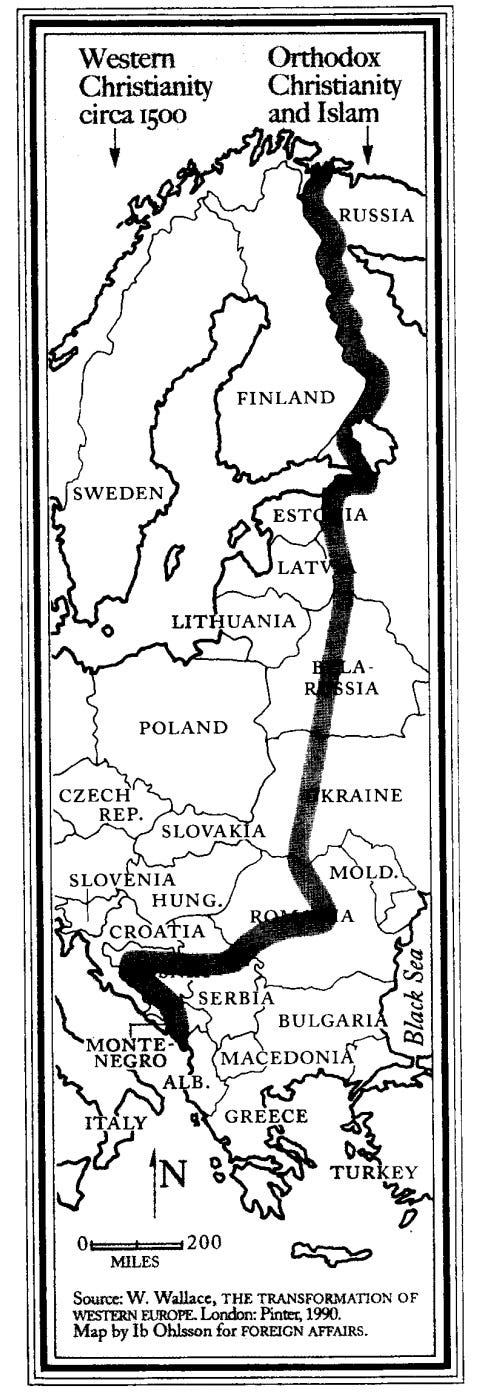In his “Clash of Civilizations” (1996) Samuel P. Huntington identified eight civilisations on this planet:
Confucian, Japanese, Hindu, Buddhist, Islamic, Western, Orthodox, Latin American, and, possibly, African
I have always found this list a bit dubious, not to say self-contradictory:
Western and Islamic. Buddhist and Latin American. African and Orthodox. Japanese.
You know what does this classification remind to me? A fictional “Chinese Encyclopaedia” by an Argentinian writer Jorge Luis Borges:
In its remote pages it is written that the animals are divided into: (a) belonging to the emperor, (b) embalmed, (c) tame, (d) sucking pigs, (e) sirens, (f) fabulous, (g) stray dogs, (h) included in the present classification, (i) frenzied, (j) innumerable, (k) drawn with a very fine camelhair brush, (l) et cetera, (m) having just broken the water pitcher, (n) that from a long way off look like flies.
Classification presented above sounds comical. Now why would that be? That it because it lacks a consistent classification basis. The rules of formal logic prescribe us to classify things consistently. For that to happen, you should choose one principle (e.g. size) and hold to it. You cannot classify berries into the red, exotic, expensive, poisonous to dogs, growing only in Peru, and the ones you tasted in childhood.
But that is exactly what Huntington is doing here.
Islam, Hinduism and Buddhism are religions, and Confucianism can also be counted as a religion for all practical purposes.
Orthodoxy. Well, now that is a sect within a religion, classified into a separate civilisation for the seemingly arbitrary reasons.
West. That is a compass direction. Speaking seriously, the Huntingtonian “West” appears to encompass historically Catholic and Protestant countries, minus the poorer ones, classified into a separate civilisation of Latin America.
Africa. Well, that is a non-Muslim part of Africa that you don’t know where to fit. On the one hand, you cannot count it as Muslim, because it is not. On the other, you do not want to count Christian Africa as the West either. So, it is kinda hanging in limbo.
***
So, is it a good classification? No, it isn’t. It is a bad system, torturing the principles of formal logic. It is bizarre, idiosyncratic and wrong.
But
That does not mean we cannot work out anything out of it. “Bad” ideas often hold a grain of important truth. So, you should not automatically dismiss an idea simply because it is wrong. Better, polish it, and process it into something better.
Does the (wrong) Huntingtonian classification contain a grain of important truth within it?
I think it does.
Let’s take a glance at the “Western” vs “Orthodox” border, for example. Western vs Orthodox framing doesn’t make much sense, breaking the rules of formal logic. That, however, does not mean that the dichotomy between two separate regions is made up. To the contrary, it is very real as everyone who had ever travelled from Helsinki to St Petersburg can testify. The line is real, the framing is wrong.
So how can we improve the framing?
My answer:
Change “Western” to “Latin”
Then it all suddenly starts making sense.
This border separates the world of Latin Christianity, from the non-Latin countries to the east.
Keep reading with a 7-day free trial
Subscribe to kamilkazani to keep reading this post and get 7 days of free access to the full post archives.




